Interviews / Artists’ movies
Muck and brass:
Bill Morrison and Jóhann Jóhannsson on ‘The Miners’ Hymns’
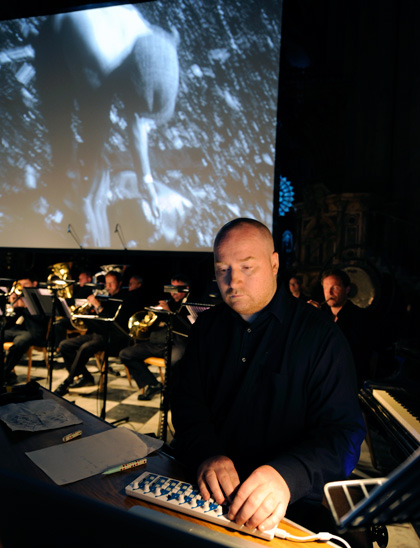
Jóhann Jóhannsson rehearsing The Miners’ Hymns.
Photo ©Colin Davison, courtesy Forma Arts and Media
US experimental film-maker Bill Morrison and Icelandic musician Jóhann Jóhannsson have collaborated on a new tribute to Britain’s old colliery culture, brass bands and all. Nick Bradshaw talks to the pair on the eve of their Durham Cathedral premiere
County Durham may have covered over the rich seam of deep coalmines that made its industrial name, but its capital city continues to mark the annual Durham Miners’ Gala, as well as the workers’ brass-band culture that came out of the pit. This year’s BRASS festival promises a particular treat: the world premiere, performed live over two nights in Durham Cathedral, of a new film by Bill Morrison, in which archival images of British miners at work and play (and on the march) are re-edited to a new brass-band score by Jóhann Jóhannsson.
Morrison is the US experimental film-maker best-known for his 2002 filmic dance-of-death Decasia, in which the original imagery on semi-salvaged old films conducted a dialogue with its own decay, although he’s also known for films from 1993’s The Death Train to The Mesmerist (2003) and Light is Calling (2004); he’s worked with composers from Bill Frisell and Michael Gordon to Henryk Gorecki, Steve Reich and Harry Partch. Jóhannsson himself has worked with fellow musicians from Barry Adamson to Marc Almond, as well as collaborating on films, books, radio shows and exhibitions. The pair answered my questions in turn over the telephone from a hotel room in Durham; what follows is a synthesis of their consecutive conversations.
How did you each come to this project?
JJ: David Metcalfe from [creative producing agency] Forma contacted me to ask if I wanted to be involved with the project and mentioned the possibility of working with Bill. I knew his film Decasia and it seemed an interesting proposition. And the idea of working with a brass band and the whole subject of this industrial archaeology were fascinating to me.
BM: It came quite out of the blue for me. I guess David was familiar with Decasia and imagined that this would involve a lot of archival footage, so I guess my name came to his mind and he called me up. Of course I had an idea there were coal mines in England, and I was aware of was the big strike in ’84. But beyond that I certainly didn’t know about the Gala, the banners or the miners’ bands, any of this. And of course we hadn’t heard much about mining communities in England for a while.
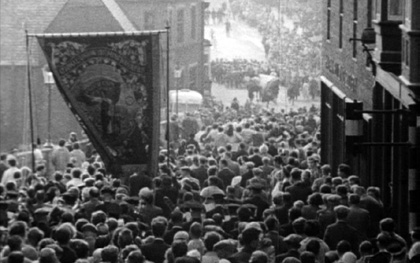
Miners’ Gala Day, Durham, 1963
I wasn’t familiar with Jóhann’s music either, but when I started asking around in New York a lot of my friends were like, “Oh, that guy’s great!” One had just been to a record store in Iceland, asked “What’s cool?” and been given his records. Another had just found him through the internet.
I’ve gotten to see him live twice in New York since, as well as here in Durham last year when I showed a couple of films that he performed, so I’ve gotten familiar with his music. It’s often described as cinematic music – it’s very easy to edit to. What’s difficult is music with a lot of notes; instead this swells, so you just hook on to these different levels of escalating emotion. I don’t mean to make it sound facile, but it came together quite nicely.
Mining is obviously an international phenomenon but I don’t know that colliery bands are. What did this kind of industrially-rooted music mean to you?
JJ: I’d had very little exposure to, or even knowledge of, colliery music before I signed up and started researching. But I do have a connection with brass bands: my first instrument was trombone, and in my early teens I played in a brass band connected with one of the workers’ associations. My father was a percussionist in a brass band for years, too, and the big event of the year was always the First of May Workers’ Parade. So I have some experience of that culture and music.
What I found interesting was how big a part of the culture it is, or was; the way that these bands were comprised of miners and were a way for the miners to be culturally and artistically active. They played at weddings, funerals, the Miners’ Gala – it was cradle-to-grave. And through this I found out about the ‘pitmen painters’, the Ashington Group of miners who found expression through painting and art. It’s very common in Iceland, this music-making and artistic expression by non-professionals. The brass band tradition is not as big, but there are choirs everywhere. So that’s something that is familiar to me.
BM: Of course most musicians have day jobs. There’s a tradition of sidemen, working stiffs who play music at night. But this was fairly unique, with a brass band for every mine, almost like a sports team, all being competitive with each other.
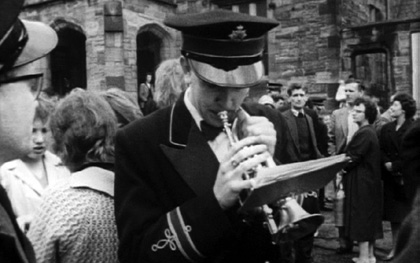
Miners’ Gala Day, Durham, 1963
There are literally thousands of collieries in the States, but there wasn’t a single industry that dominated the entire country the way that coal dominated England. I guess a comparison could be made with the US auto industry, in terms of rise and fall, and the unions being simultaneously squashed [in both countries]. But I’m not aware of the auto workers having a sub-culture or counter-culture or whatever, if you want to call the colliery bands and the painters that.
Jóhann, how closely have you hewn to the sounds of colliery bands?
JJ: There are subtle references, but I didn’t want to make a pastiche or something too referential. I think I’m working with the texture of the brass band more than anything, and trying to find new ways of employing that within the context of my music. It’s maybe a continuation of a piece called Virðulegu Forsetar I wrote in 1997 for brass, organ and electronics, but taken further.
One type of brass-band music that touched me the most was the church hymns they played. Our title is from a hymn I found called Gresford, subtitled or nicknamed The Miners’ Hymn, written by a miner [Robert Saint] about a colliery accident in which several hundred miners were killed. It’s amazingly beautiful, especially played with a brass band; it just has this really strong emotional resonance.
But it seemed too easy just to take that and put it in the context of old archival footage; it’s instant emotional reaction. So I’m referring to it in subtle ways: the last piece, for example, is a kind of hymn, but a very modern one, filtered through Icelandic two-part folk song, a sort of oral tradition in which two singers sing in parallel fifths that is very peculiar to Iceland.
So it’s a homage filtered through my own sensibilities. I try to take all these influences and create something that hopefully has resonances to this world and culture, but I didn’t want to be too much of a tourist and appropriate things.
What surprised or delighted you the most about what Bill pulled out of the vaults?
JJ: Well, I love old industrial imagery and smokestacks belching pollution, maybe because Iceland doesn’t have any industry, just mountains and beautiful nature. The kind of industrial wasteland that you see in so much of Europe has a tremendous poignancy to me, especially when it’s run down and you see the collapse and failure of this system. And also how nature reclaims it.
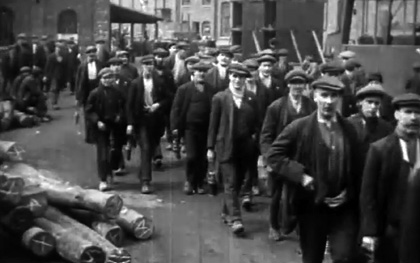
Manvers May Day Parade, 1919. Courtesy of Yorkshire Film Archive
Bill made these amazing shots of the sites of former mines that have been closed down and reclaimed, not always by nature – sometimes by supermarkets.
Your reactions sound much like our feelings for those old decaying films that Bill’s famous for reclaiming.
JJ: Yeah, but there’s a tremendous human element to the project too. It follows the miners – it’s almost a day [in the life] of a miner. We felt it should follow this whole process and experience, trying to get an inkling of what it felt like to work in these conditions. And there’s a lot of footage related to the political and economical struggles, the strikes and closing of the mines, but also of celebration: the Gala and its culmination, when the banners are blessed. So it’s also a homage.
Bill, there are some fairly obvious parallels between going down the pit and digging around in the archives – and in both cases we’re looking at something now lost. Was there a necromantic aspect that appealed to you?
BM: Yeah. You’re the first journalist I’ve talked to who’s made that connection, but it was a running joke about going back to the coal mines.
I think I did three different trips to the BFI National Archive (which of course was our go-to resource) to hole up in one of those editing rooms, just going through the mass of materials – plus all the time I spent in my computer – and there was certainly a feeling that I was chipping away at pieces of archive stored in the wall and bringing them up to the light. Just typing the four letters ‘COAL’ into the BFI database brings up literally thousands of titles. We were lucky that this dove-tailed with the BFI’s industrial heritage project, because everyone was quite familiar with the material and there were some very beautiful transfers just made.
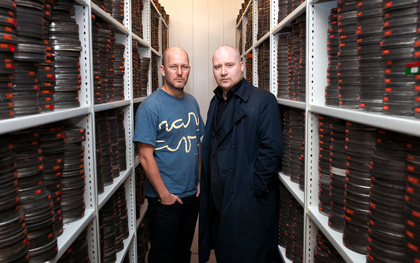
Bill Morrison and Jóhann Jóhannsson
I don’t make the explicit reference to film-making here that I have in my past work, but it’s incredibly cinematic stuff. In the first place, the old footage has very rich blacks in the 35mm negative: they were sending really top-notch cinematographers down there, producing 35mm black-and-white neg. We transferred that stuff at 1920x1080 pixels, 24 frames per second, so it’s stunning, absolutely gorgeous. Just to see a black wall of coal that’s shimmering as the coal is being dislodged; with a lesser grade of resolution it might not look anything, but I think this is going to look quite stunning, especially in the Cathedral, where we’re going to have a 20K projector. I’m excited about it.
So it is all pretty clean. The original footage that we shot was 16mm, and that got transferred with the same specs. I guess if there’s something that’s grubby, it’s the news footage from 1984, which was a necessary thing to include. Really, we get away with how grubby it is because of how pristine everything else is. But that [decadent imagery] is not a direction I went with this; there was no need to, for one thing. And it’s tricky material: you’re dealing with people’s lives and community and you want to make sure you’re understood.
Are you still happy to be considered an archival film-maker? I don’t know if it’s a pigeonhole…
BM: Well, let’s say that I’m pigeonholed – but I think there are endless ways of dealing with archive footage. This is my third project in 2010. The first, Release, took a single piece of footage, a minute-long pan of a crowd waiting for Al Capone to be released from Eastern State Penitentiary, and re-edited it into a 13-minute-long split-screen loop for installation. The jazz composer Vijay Iyer worked on the sound design. It’s making the festival rounds right now, but it’s also a standing installation at the very penitentiary where the footage was shot. That was one approach.
Another, also with a jazz composer, Dave Douglas, is called Spark of Being. It takes the Frankenstein story and retells it using archival footage. I’m actively submitting to festivals now but it hasn’t premiered yet.
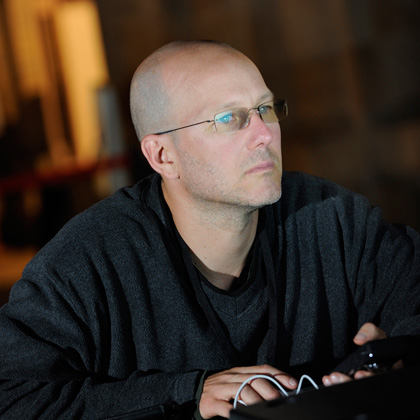
Bill Morrison rehearsing The Miners’ Hymns.
Photo ©Colin Davison, courtesy Forma Arts and Media
And then there’s this somewhat poetic treatment of a very specific era and subject matter. So I feel I’m able to flex different muscles within the context of archival footage. And then of course I have a great romance with decay and footage that becomes something else before your eyes. I think I’m more specifically known as someone who works on the fringes of archival footage, and I’m happy with that.
How do you both see the life of the piece beyond these two screenings?
JJ: We’re coming back to Durham Cathedral in September to record the project. And then I believe it will be released on DVD, and CD as well, I guess. And if it goes well, perhaps we’ll tour the piece to other places?
BM: We’ll certainly cut a DVD if not a Blu-ray or HD, once the music’s done. I had an email today from Peter van Hoof at Rotterdam, saying he just got an announcement about the film and asking if it’s ready. So I guess there’ll be interest.
‘The Miners’ Hymns’ are produced by Forma for BRASS: Durham International Festival 2010, and performed at Durham Cathedral on 15 and 16 July.
See also
Going underground: Lee Hall on the BFI National Archive’s treasure trove of films about the mining industry, and the lost set of values it reveals (October 2009)
‘Underground’, overground: Nick Bradshaw and James Bell watch two showcases of archive restorations at the 2009 London Film Festival (online, October 2009)
We have always recycled: Rick Prelinger sketches an alternative history of the rise of ‘archive fever’ (online, March 2010)
Decasia reviewed by Tony Rayns (December 2003)
Like Father reviewed by Richard Kelly (July 2001)
The smouldering screen: Kevin Brownlow on the lustre of nitrate (online, July 2010)
Mining Review: 1st Year (1947-48) (and related films and TV programmes) at BFI Screenonline
